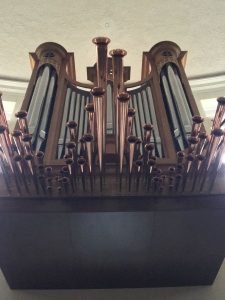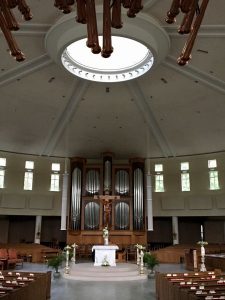St. Bede Catholic Church
Williamsburg, Virginia
Completed 2005
43 Straight Speaking Stops, 54 ranks, Across Three Manuals & Pedal
About the Organ from the Builder
The organ at St. Bede Catholic Church was the result of eight years of planning. St. Bede Parish’s communicant strength is about 3,000 families, formerly located in a small landlocked building on the William and Mary campus. The former site, now the University’s Newman Center, simply could not accommodate the parish’s phenomenal growth, nor could the entire parish worship together. When planning the new building, St. Bede’s Pastor, the Rev. Fr. William Carr, insisted that the new church include a pipe organ, and that the organbuilder be commissioned to work with the architect from the beginning. The new building, designed by architect Tom Kerns and Sean Riley, seats 1,500 and is expandable to 2,000. The then Music Director and later consultant for the project, Steve Blackstock, formed a Musical Instruments Committee which selected us and we began to work with the Kerns Group in the building’s and instrument’s design. The Instruments Committee shared our belief that the organ would be most successful if it were installed in a free-standing case speaking to the entire assembly.
As the building’s construction process unfolded, the cost estimates exceeded projections. Significant “value engineering” of the building was undertaken of the building and the organ: certain stops in the specification were deferred as “preparations for future installation,” and case details (especially the pipe shades) were simplified. As the building began to take shape, Monsignor Carr was able to fund the entire organ, so work proceeded apace. Unbeknown to us, during construction the Church’s contractors erroneously sprayed acoustically dampening material (K-13) over the entire ceiling of the Church, instead of just the central lantern, as the acousticians had specified. We were not consulted about this and were completely surprised by this condition when we arrived with the organ – which was scaled and voiced for a planned generous acoustic of 5 seconds, with an even frequency response and dispersion.
When the organ’s initial tuning was completed, we observed that the K-13 was altogether too successful in accomplishing its mission of deadening everything close to it. This meant that the Great and Pedal divisions’ pipework at the top level was severely out of balance with the Swell and Choir division below it, and throughout the entire organ, pitches from about 2’C were drastically attenuated. Our Tonal Director re-calculated cut-ups and toe holes for all the flue pipes above 2’C and the entire tonal finishing crew was set to re-voicing basically more than half of the organ – 2,000 pipes – on site. The reeds did not suffer to as great a degree as the flues; we were able to boost them by adding curve to the tongues from about 2’C upward. We placed the console near the Ambo to listen for balances during tonal finishing because the mis-applied K-13 limited the best listening locations to the Ambo, the Altar area and the perimeter of the room. Ironically, the worst place to hear the organ is directly in front of it.
The organ case stands three stories tall and is made of 1½” thick solid white oak and white oak veneers. Walnut is used for the simple pipe shades and accenting trim details. The facades incorporate pipes of the Great 16’ Double Open Diapason (the low 20 notes of which are shared in the Pedal), the Great First and Second 8’ Open Diapasons, and the Pedal 8’ Principal. The 16’ Pedal First Open Diapason of wood stands behind the organ case and is stained and finished in a dark walnut color. Resonators of the low octaves of the pedal 32’ & 16’ Trombones are made of beautiful, clear pine, continuing upscale in thick 52% tin pipe metal as this stop becomes the manual Trombas, voiced on 7” wind. The big Tuba stands vertically in the Choir box just behind the shutters, and is certainly the Trombas’ big brother, being voiced on nearly 30” pressure!
The Processional Organ’s case is also of white oak, to match the Main Organ. Its pipe shades are carved basswood (which the Main Organ’s were supposed to be). Celtic crosses have been cut into the tower tops and are enameled in rich, dark purple, and outlined in gold leaf in homage to Father Carr’s elevation to Monsignor status. When played with the Main Organ, the Processional Organ’s two Principal stops have the effect of “pulling” sound out of the Main Organ’s case, and surrounding the listeners with an incredibly inescapable, voluptuous tone. The console, also constructed of 1½” thick white oak, is attached to an easily moved platform.
Our instruments are liturgical organs which play literature remarkably well. Our style is in direct response to the need for an organ to function liturgically and musically in a particular denominational setting, but not at the expense of a particular historical, national, or idiosyncratic musical style. Only a classic concept of organbuilding can truly accomplish this; in our style the classicism is musically tempered by a more romantic cast to the voicing, our greatest inspirations being the organs of Henry Willis and Aristide Cavaille-Coll.
Slider wind chests keep the tonal design physically honest, and offer speech, voicing, and tuning advantages (as well as virtually no long-term maintenance). Our proprietary Slider Pedal Chest allows us to play a single rank of pedal pipes at several pitches – without giving up slider chest speech, tuning stability, and repetition characteristics. Because they’re pedal stops and usually only one note is played at a time, we can scale these individual ranks to be appropriate for two or three tonal contexts and save the client some money.
Although we were one of the first American organbuilders to re-introduce the Tuba into modern practice, in 1991 at the Chapel of St. John the Divine, our tonal innovations are often of a subtler (and quieter) nature. For example, in this organ we have specially developed Dolcan-shaped pipes for the metal top octaves of open wood ranks; they sound like wood pipes, but stay in tune. We have developed Walter Holtkamp’s Ludwigtone as our Flute Cœlestis, its plaintive and gentle celesting tone evocative of something heavenly, which explains the pun in the nomenclature. We have refined the 18th century French Flûte à Bibéron (“Baby-Bottle Flute”) to be a colorful chimney flute tone suitable for solos, the foundation of a flute chorus, or secondary foundation for a principal chorus.
Despite the severe acoustical challenge, the sound of the organ is warm and rich, filling the space nicely with a generous foundation. Each chorus has its own distinctive color, so there is no redundancy within each family of sound. The organ can lead congregational singing with a wide variety of colors at many different volume levels. And, recitalists aren’t disappointed in the tonal resources and the informed manner of their disposition and execution.
Everyone seems to have found a favorite stop in this instrument. The Pontifical Trumpets titillate the eye and ear and most visitors want to hear them right off the bat. My then 16-year-old son Stephen, already an accomplished organist, fell in love with the Choir 8’ English Open Diapason while preparing a recital for the Tidewater POE. “It has something to tell you,” he said. Shouldn’t pipe organs have as strong an emotional appeal as intellectual, so that when played they grab you and don’t let you go?
My mentor, Henry Willis 4, told me that truly great organs are only created when 90% of the builder’s effort is expended upon the last 2% of the project. After the organ is built, installed, and voiced, it’s that last step of careful, time-consuming, painstaking tonal finishing that imparts a living soul into the instrument. That you feel “connected” while listening or playing is no happy accident, but the result of careful listening by the finisher and exacting craftsmanship on the part of the voicer working on the pipes. It is only when one is working at this level that organbuilding is truly an art. And, it is only when wonderful clients appreciate and value the difference that truly world-class pipe organs are commissioned. – John-Paul Buzard
Stop List
16′ Double Open Diapason (tin façade)
8′ First Open Diapason (tin façade)
8′ Second Open Diapason (ext. 16′)
8′ Viola da Gamba
8′ Claribel Flute (open wood)
4′ Principal
4′ Spire Flute
2 2/3′ Twelfth
2′ Fifteenth
1 3/5′ Seventeenth
2′ Fourniture V
Cornet (TC) V Preparation
Trumpet 8′ Preparation
8′ Tromba (Pd) (ext. 16)
4′ Clarion (ext. 8′ Tromba)
8′ Major Tuba (Ch)
8′ Tuba Solo Melody Coupler
8′ Pontifical Trumpets
8′ Violin Diapason
8′ Stopped Diapason (wood)
8′ Salicional
8′ Voix Celeste
4′ Principal
4′ Harmonic Flute (open metal)
2′ Octavin
2 2/3′ Full Mixture V
16′ Bassoon (full length)
8′ Trompette
8′ Oboe
4′ Clarion
Tremulant
8′ Major Tuba (Ch)
8′ Pontifical Trumpets
16′ Leiblich Gedeckt
8′ English Diapason
8′ Flûte à Bibéron
8′ Flute Cœleste (doubled open wood)
4′ Principal
4′ Suabe Flute (open wood)
2 2/3′ Nazard
2′ Recorder
1 3/5′ Tierce
1 1/3′ Mixture IV
16′ English Horn, Preparation
8′ Clarinet
Tremulant
Cymbalstern
8′ Major Tuba (30″ wind)
8′ Pontifical Trumpets (5 1/2″ wind)
8′ Open Diapason (tin façade)
4′ Principal
32′ Double Open Diapason (1-12 digital)
32′ Subbass (1-12 digital)
32′ Lieblich Gedeckt (1-12 digital)
16′ First Open Diapason (open wood)
16′ Second Open Diapason (Gt) (tin façade)
16′ Bourdon (ext. 32′)
16′ Lieblich Gedeckt (Ch)
8′ Principal (tin façade)
8′ Bass Flute (ext. 1st)
8′ Bourdon (ext. 32′)
8′ Gedeckt Flute (Ch)
8′ Spire Flute Preparation
4′ Choral Bass (ext. 8′)
4′ Open Flute (ext. Bourdon)
32′ Contra Trombone (wood, ext. 16′)
16′ Trombone (wood)
16′ Bassoon (Sw)
8′ Trumpet (ext. 16′)
4′ Clarion (ext. 8′)
8′ Major Tuba (Gt)
8′ Pontifical Trumpets
The organ has a full set of inter and intra-divisional couplers.








